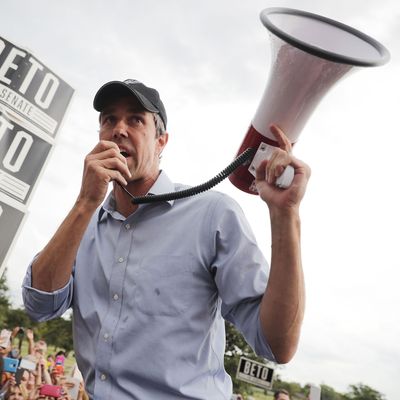
On Halloween afternoon, somewhere on the highways of San Antonio, Beto O’Rourke’s road-trip campaign for the Senate hit a very Texan obstacle: a traffic jam. O’Rourke, the Democrat running against Ted Cruz, was late for a rally on the historically Hispanic west side of town, and he was facing several urgent deadlines. The trick-or-treating hour was looming, as were a bunch of big bruise-colored thunderheads. And it was already the tenth day of early voting in Texas, which meant that even as he sat — and sat — behind the bug-splattered windshield of a Dodge minivan, Texans were deciding the fate of his campaign. Effectively, it was already Election Day.
As usual, O’Rourke was broadcasting live to Facebook as he drove, so he used a few of his last, precious moments to talk about a topical issue: Halloween. He discussed his positions on candy. (Yes to Twix and candy corn; no to Butterfinger, because it sticks to his teeth.) He called his wife Amy, back in El Paso, for an update on their three kids’ costumes. He had a campaign aide retrieve a photo from a few years ago. “I’m trying to be John Travolta in Pulp Fiction,” O’Rourke said. “But I just look like me in a white shirt.” Whatever the outcome this election, he won’t be able to complain — like many long-shot challengers — that the people of Texas never had the chance to get to know him.
Perversely, that may prove to be a mixed blessing. Midterm elections are typically a referendum on the incumbent party, but this year’s race in Texas has a different dynamic. By mounting a spirited, wish-fulfilling challenge to Senator Ted Cruz, O’Rourke has become a progressive political star, raising nearly $70 million, largely in small online donations. The stunning fundraising numbers have created a media feedback loop: rapturous national coverage spurs more donations, inspiring even more coverage. For O’Rourke, though, this Beto-mania has come with a strategic drawback. Somehow, an election involving one of the most famous — and among Democrats, despised — Republicans in the country has become all about Beto. One Texan political commentator joked to me earlier this year, when I was writing my own feature, that it “ought to be reported as in-kind donations to the Cruz campaign.” And Cruz has gratefully accepted, attacking his opponent as a self-absorbed hipster liberal “too reckless for Texas.”
Over the summer, as some polls showed O’Rourke running nearly neck-and-neck with Cruz, the New York Times reported that White House officials were warning donors that they were in real trouble in Texas. But then Cruz savaged O’Rourke in their first debate. (In response to a softball question about a quality he admired in his opponent, Cruz replied that he seemed genuinely committed to his socialist beliefs.) A second debate was canceled, and the final one — featuring an uncharacteristically combative O’Rourke —felt like a draw. Cruz called on his once-bitter rival for the 2016 presidential nomination, Donald Trump, for more help. The president attacked O’Rourke as a “flake” on Twitter and headlined a recent Cruz rally that drew a capacity crowd to an arena in Houston. The Republican message — “STOP THE RADICAL LEFT,” warns a commercial currently running on the San Antonio airwaves — appeared to have worked as intended. In a recent poll by the University of Texas and the Texas Tribune, which showed O’Rourke trailing by five points, nearly half of all likely voters expressed a negative view of him.
O’Rourke’s hopes have always hinged on the definition of “likely.” He believes that his campaign is mobilizing a legion of previously disengaged voters, who don’t show up in the polls. That theory has been buoyed by reports of heavy turnout for early voting, particularly in the large urban counties O’Rourke will need to dominate in order to have any shot at becoming the first Democrat elected in Texas in a generation. In Bexar County, where San Antonio sits, more than 30 percent of the registered electorate had already voted by Halloween, double the percentage for the same period before the last midterm election, and comparable to that of the 2016 presidential election. When O’Rourke finally reached his rally, he was greeted by a hundred or so supporters, diehards who had waited in the nearly treeless park despite a severe thunderstorm warning.
A mariachi band played a play a jaunty tune as O’Rourke jumped out of the minivan. “Olé!” the crowd shouted, and then a lone voice added, “Beto for President!” Someone in the crowd handed O’Rourke a Spurs cap, which he jammed on, and then he climbed up onto the bed of a pickup truck. “You name the challenge, we are up to it at this moment,” he shouted through a bullhorn. “We will ensure this great country, greatest that the world has ever known, fully lives up to its promise and to its potential. That we are defined not by our fears, not by who you’re supposed to be scared of, but by our ambitions.”
The sky flashed as O’Rourke, already the tallest thing around, waved the bullhorn over his head. It seemed for moment as if lightning might strike in Texas in a non-metaphorical way.
I retreated to my car just as the skies opened up in a deluge. I pulled up Facebook on my phone, and to my mild surprise, discovered the live video stream was still going. O’Rourke was standing by the van, rain dripping off the brim of his cap, taking selfies with a line of supporters waiting an ankle-deep puddle, some of them in drenched costumes. Looking ecstatic, O’Rourke did a little shoulder-rolling dance for the camera. “A little rain doesn’t stop us!” he shouted. Someone’s umbrella blew away.
***
The latest FiveThirtyEight.com forecast says that O’Rourke has around a 20 percent chance of winning on Tuesday, which is around 20 percent more than most of the smart people in politics give him. After the Brett Kavanaugh hearings, Cruz opened a large lead in the polls, and some Democratic leaders went so far as to suggest that O’Rourke — who has received little institutional support from the party — should start redistributing his huge fundraising haul to endangered Democratic incumbents in other states. But in the closing days of the campaign, after a pugnacious final debate performance and a series of polarizing moves by Trump on immigration, O’Rourke’s has been closing the gap. He will likely outperform any Texas Democrat in a generation. But that may not be enough. “You know what you call a Republican that only wins by single digits in Texas?” Evan Smith, the veteran journalist who co-founded the Tribune, joked to me a few months ago.
“Senator.”
I know all this, and yet, historic political waves — the kind the Democrats would need if they were to win in Texas — rarely show themselves far in advance. In his recent book The Red and the Blue, the political analyst Steve Kornacki recounts the 1994 midterm elections. Going in, Bill Clinton’s Gallup approval rating was around 40 percent, but he felt confident beforehand, coming off a series of invigorating campaign appearances that brought back memories of his insurgent election two years before. (Every word in that sentence could also apply to Trump.) Instead, Democrats received a historic drubbing as even candidates that Clinton had championed, like Governor Mario Cuomo, were upset. “There is a revolution in the air,” the veteran newsman David Brinkley declared on ABC on Election Night. But that was only after the results were in.
“When there’s a real wave, everything starts to go, and even the wildest reaches suddenly become competitive,” Kornacki told me recently via email. If you are a Democrat, hoping to retake the Senate in 2018, that’s where the case for irrational optimism begins.
For O’Rourke, an irrationally optimistic path to victory starts in the urban counties of Texas, like Bexar, which have large populations of blacks, Latinos, and other working-class voters that, in theory, are inclined to vote Democratic. It continues through the suburbs of Dallas and Houston, which have been traditionally been solidly Republican, but are filled with middle-class women who, in theory, may have been turned off by Trump. And it also depends on holding down Cruz’s margins in the Friday Night Lights section of the state, the vast, conservative hinterland, where O’Rourke, defying conventional wisdom, has spent a great deal of his campaign. (Even in the final stretch of late October, he took time out for appearances Lubbock, Amarillo, and Wichita Falls.)
“The good news,” O’Rourke said at a get-out-the-vote rally in Austin on Wednesday, “is that all the hope has been turned into action, and into votes.” In a state with a weak Democratic Party organization, he has had to devote a substantial portion of the money he has raised to building a new kind of political machine. Now it’s time to see if it really works.






























